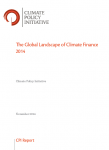A study by the Climate Policy Initiative (CPI) has found that total flows of global climate finance in 2013 totaled US$331 billion, representing a fall for the second consecutive year.
The report, titled ‘The Global Landscape of Climate Finance 2014,' aggregates data from various sources with the aim of providing policy makers with comprehensive information on the scale, key actors, instruments, recipients and uses of climate finance.
 November 2014: Total flows of global climate finance fell for the second consecutive year, according to a study by the Climate Policy Initiative (CPI). The report, titled ‘The Global Landscape of Climate Finance 2014,’ aggregates data from various sources with the aim of providing policy makers with comprehensive information on the scale, key actors, instruments, recipients and uses of climate finance.
November 2014: Total flows of global climate finance fell for the second consecutive year, according to a study by the Climate Policy Initiative (CPI). The report, titled ‘The Global Landscape of Climate Finance 2014,’ aggregates data from various sources with the aim of providing policy makers with comprehensive information on the scale, key actors, instruments, recipients and uses of climate finance.
Global climate finance totaled US$331 billion in 2013, according to the CPI report. Public actors and intermediaries accounted for US$137 billion and private investors provided US$193 billion in climate finance flows in 2013. While public flows remained relatively constant, private flows fell by US$31 billion from 2012.
Flows were split almost evenly between Organisation for Economic Co-operation and Development (OECD) countries and non-OECD countries. The amount flowing from developed to developing countries decreased by US$8 billion compared to 2012. Nearly 75% of total climate finance investments, and 90% of private investments, took place in the country of origin.
The report notes that the fall in overall climate finance levels is largely due to the falling cost of solar photovoltaic (PV) and other renewable energy technologies. Still, the report underscores that “the situation remains grave,” pointing to a study by the International Energy Agency (IEA), which estimated that an additional US$1.1 trillion in low-carbon investments is needed each year through 2050 in the energy sector alone to stay below the 2°C target.
Key messages to policy makers on where to focus policy and public resources include: the importance of focusing efforts on decreasing technology costs, alongside mobilizing finance; that public resources remain key drivers of the climate finance system; and that domestic policy frameworks are paramount, in particular for driving private investment.
A factsheet titled ‘A Closer Look at Public Adaptation Finance,’ launched alongside the report, highlights that global public adaptation finance increased by at least 12% between 2012 and 2013, to US$25 billion. Development finance institutions, with a 88% share, were the largest source, followed by governments, at 9%, and climate funds, at 2%. CPI notes that the 2013 levels fell short of what is needed in a world where the average temperature rise exceeds 2 °C. [CPI Publication Webpage] [Publication: Global Landscape of Climate Finance 2014] [CPI Factsheet on Public Adaptation Finance]